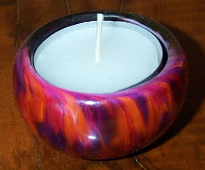Special caution with candles and tea lights
We all know that we must take extra precautions when handling candles. They can easily fall over and accidentally ignite a fire. Therefore we’re already aware of their danger. But what about a candle or tea light containing a special ingredient that makes it extremely flammable? First of all, it shouldn’t be in the candle or tea light. Secondly, you never suspect that something is wrong with it until something unusual happens. This happened to me last year on Christmas.
I had bought a bag of tea lights at Ikea in Renton in summer of 2006. Though these candles are already in a metal container, I always place them in another glass container before lighting them. The container is a glass salt, which I had bought at a glass studio close by my place. When I lit these tea lights, I thought that nothing bad could happen. But I was in for a surprise.

The days before and during Christmas time, I always placed three tea lights on a window-sill in front of one of my kitchen windows. In the evening I lit the candles and let them burn down. Sometimes I went to bed, while the candles were still burning. I wasn’t aware that some of the tea lights were extremely flammable. And why should I?
In the evening of Christmas day, December 25, I placed three tea lights in front of my window and lit them. While I watched TV, the candles were burning. I believe it was between 9 and 10 PM, when I heard a loud cracking sound coming from my kitchen. Since I had never heard this sound before in my apartment, I got up to see what this is all about.
When I walked into the kitchen, I saw thick black smoke covering my window. Additionally, I noticed that the tea light on the furthest right was engulfed in flames. It certainly didn’t burn like a regular tea light, and the glass salt was hot like a burning oven. At that moment I had no doubt that something must have been wrong with the tea light. I extinguished the fire and left the glass salt, with the tea light in it, sitting on the window-sill because it was too hot to handle.
The following morning I examined more precisely the damage. Firstly, I noticed that the glass of the window had a crack on the far right side. That’s why I had heard the cracking sound the previous evening. Secondly, when I picked up the glass salt, I saw a round burn mark on the window-sill, where I had placed the glass salt. The glass salt container had become so hot the previous evening that it had left a burn mark.
Right away I called Ikea and told a service manager what had happened. The manager asked me to bring whatever was left of the tea light to their office. The substance remaining in the metal container of the tea light was not like the usual wax. It was a thick black crumbled substance. The manager asked me, to leave, what was left of the tea light, with their office, and she told me that Ikea would pay for the repair of the glass window and window-sill. And they did. Ikea paid for the repair of my glass window, window-sill, and reimbursed me for the cost of the bag of tea lights.
I still would like to know, what kind of ingredient had been in the tea light or its metal container. It must have been a highly flammable substance burning with extremely high temperature. Only an extremely high temperature caused the thick glass salt to become so hot that I couldn’t touch it after I had extinguished the fire.
Fortunately, I’d been at home and not sleeping when the fire broke out. Up to that time, I had thought that a tea light would not pose a grave danger. However, this experience taught me otherwise.